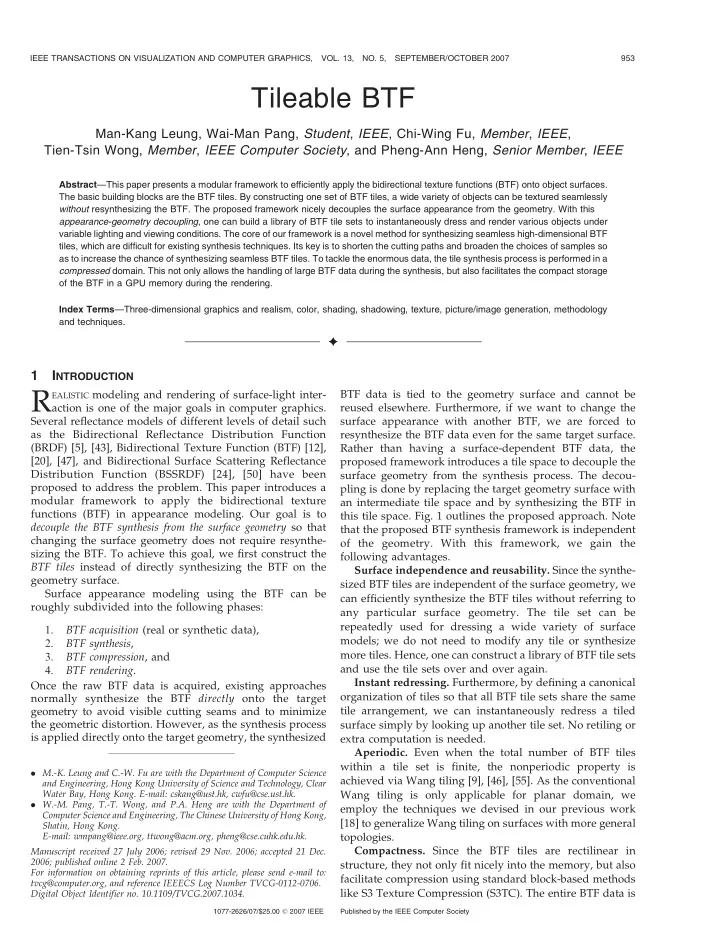

IEEE TRANSACTIONS ON VISUALIZATION AND COMPUTER GRAPHICS, VOL. 13, NO. 5, SEPTEMBER/OCTOBER 2007 953 Tileable BTF Man-Kang Leung, Wai-Man Pang, Student , IEEE , Chi-Wing Fu, Member , IEEE , Tien-Tsin Wong, Member , IEEE Computer Society , and Pheng-Ann Heng, Senior Member , IEEE Abstract —This paper presents a modular framework to efficiently apply the bidirectional texture functions (BTF) onto object surfaces. The basic building blocks are the BTF tiles. By constructing one set of BTF tiles, a wide variety of objects can be textured seamlessly without resynthesizing the BTF. The proposed framework nicely decouples the surface appearance from the geometry. With this appearance-geometry decoupling , one can build a library of BTF tile sets to instantaneously dress and render various objects under variable lighting and viewing conditions. The core of our framework is a novel method for synthesizing seamless high-dimensional BTF tiles, which are difficult for existing synthesis techniques. Its key is to shorten the cutting paths and broaden the choices of samples so as to increase the chance of synthesizing seamless BTF tiles. To tackle the enormous data, the tile synthesis process is performed in a compressed domain. This not only allows the handling of large BTF data during the synthesis, but also facilitates the compact storage of the BTF in a GPU memory during the rendering. Index Terms —Three-dimensional graphics and realism, color, shading, shadowing, texture, picture/image generation, methodology and techniques. Ç 1 I NTRODUCTION R EALISTIC modeling and rendering of surface-light inter- BTF data is tied to the geometry surface and cannot be action is one of the major goals in computer graphics. reused elsewhere. Furthermore, if we want to change the Several reflectance models of different levels of detail such surface appearance with another BTF, we are forced to as the Bidirectional Reflectance Distribution Function resynthesize the BTF data even for the same target surface. (BRDF) [5], [43], Bidirectional Texture Function (BTF) [12], Rather than having a surface-dependent BTF data, the [20], [47], and Bidirectional Surface Scattering Reflectance proposed framework introduces a tile space to decouple the Distribution Function (BSSRDF) [24], [50] have been surface geometry from the synthesis process. The decou- proposed to address the problem. This paper introduces a pling is done by replacing the target geometry surface with modular framework to apply the bidirectional texture an intermediate tile space and by synthesizing the BTF in functions (BTF) in appearance modeling. Our goal is to this tile space. Fig. 1 outlines the proposed approach. Note decouple the BTF synthesis from the surface geometry so that that the proposed BTF synthesis framework is independent changing the surface geometry does not require resynthe- of the geometry. With this framework, we gain the sizing the BTF. To achieve this goal, we first construct the following advantages. BTF tiles instead of directly synthesizing the BTF on the Surface independence and reusability. Since the synthe- geometry surface. sized BTF tiles are independent of the surface geometry, we Surface appearance modeling using the BTF can be can efficiently synthesize the BTF tiles without referring to roughly subdivided into the following phases: any particular surface geometry. The tile set can be repeatedly used for dressing a wide variety of surface 1. BTF acquisition (real or synthetic data), models; we do not need to modify any tile or synthesize BTF synthesis , 2. more tiles. Hence, one can construct a library of BTF tile sets 3. BTF compression , and and use the tile sets over and over again. BTF rendering . 4. Instant redressing. Furthermore, by defining a canonical Once the raw BTF data is acquired, existing approaches organization of tiles so that all BTF tile sets share the same normally synthesize the BTF directly onto the target geometry to avoid visible cutting seams and to minimize tile arrangement, we can instantaneously redress a tiled the geometric distortion. However, as the synthesis process surface simply by looking up another tile set. No retiling or is applied directly onto the target geometry, the synthesized extra computation is needed. Aperiodic. Even when the total number of BTF tiles within a tile set is finite, the nonperiodic property is . M.-K. Leung and C.-W. Fu are with the Department of Computer Science achieved via Wang tiling [9], [46], [55]. As the conventional and Engineering, Hong Kong University of Science and Technology, Clear Water Bay, Hong Kong. E-mail: cskang@ust.hk, cwfu@cse.ust.hk. Wang tiling is only applicable for planar domain, we . W.-M. Pang, T.-T. Wong, and P.A. Heng are with the Department of employ the techniques we devised in our previous work Computer Science and Engineering, The Chinese University of Hong Kong, [18] to generalize Wang tiling on surfaces with more general Shatin, Hong Kong. E-mail: wmpang@ieee.org, ttwong@acm.org, pheng@cse.cuhk.edu.hk. topologies. Compactness. Since the BTF tiles are rectilinear in Manuscript received 27 July 2006; revised 29 Nov. 2006; accepted 21 Dec. 2006; published online 2 Feb. 2007. structure, they not only fit nicely into the memory, but also For information on obtaining reprints of this article, please send e-mail to: facilitate compression using standard block-based methods tvcg@computer.org, and reference IEEECS Log Number TVCG-0112-0706. like S3 Texture Compression (S3TC). The entire BTF data is Digital Object Identifier no. 10.1109/TVCG.2007.1034. 1077-2626/07/$25.00 � 2007 IEEE Published by the IEEE Computer Society
Recommend
More recommend